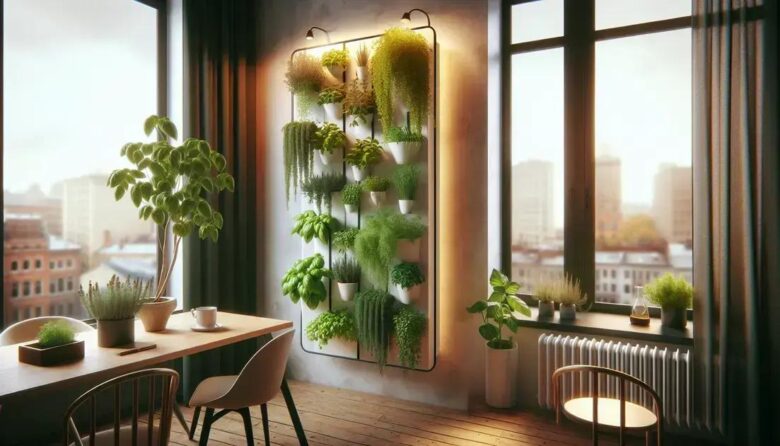Vertical planters offer a fresh take on herb gardening, especially for beginners. Imagine having a mini herb oasis right in your living room! Whether you’re short on space or just love the idea of lush greenery indoors, vertical planters are an inviting option. Curious how to start? Let’s dive into the world of herb gardening with these space-savvy solutions.
what are vertical planters and why use them
Vertical planters are innovative gardening solutions that allow you to grow plants in a vertical fashion rather than traditional horizontal layouts. They are ideal for small spaces like apartments, balconies, or any area where horizontal space is limited. Using vertical space can maximize your growing area and bring greenery to urban environments where garden space is often scarce.
These planters come in various designs, including tiered structures, hanging systems, and even wall-mounted options, allowing you to customize them according to your space and aesthetic preferences. They not only save space but also enhance the visual appeal of your living area by adding a touch of nature.
Why should you use vertical planters? Firstly, they allow for easier maintenance. Plants at different heights are more accessible for watering, pruning, and harvesting, reducing the strain of bending or reaching. Secondly, vertical planters can improve air circulation around the plants, reducing the risk of disease.
Additionally, vertical gardening can serve as a versatile hobby, offering opportunities to grow a wide range of plants, from flowers to vegetables and herbs. It can also contribute to mental well-being, providing a stress-relieving outlet in the form of gardening activities.
choosing the right herbs for beginners
Choosing the right herbs for a beginner’s garden can significantly impact your gardening success. Easy-to-grow herbs not only ensure a rewarding experience but also supply fresh ingredients for your meals. Common beginner herbs include basil, mint, rosemary, and parsley. These herbs are forgiving, adaptable, and thrive in various conditions.
Start with basil, an herb that loves sunlight and well-drained soil. Its fragrant leaves are perfect for making fresh pesto or adding to salads. Mint is another beginner-friendly herb, ideal for adding a refreshing touch to drinks. However, it’s best grown in a pot since it tends to spread quickly.
Rosemary requires minimal care once established and its needle-like leaves are great for seasoning meats and vegetables. Lastly, parsley is robust and can flourish indoors on a sunny windowsill. It’s not only decorative but also a versatile herb, complementing a variety of dishes.
Choosing a mix of herbs that match your culinary preferences will allow you to enjoy fresh flavors in your cooking while gaining confidence in your gardening skills.
how to set up your vertical planter
Setting up your vertical planter is an exciting step towards cultivating your own herb garden. Begin by choosing a suitable location. Ensure your planter receives adequate sunlight, ideally about six to eight hours a day. A south-facing window or a sunny balcony can make a great spot.
Once you’ve chosen the location, assemble your planter according to the manufacturer’s instructions. Various models are available, from wall-mounted units to freestanding towers, each requiring slightly different steps for assembly.
After assembling, select high-quality potting soil that suits the herbs you’re planning to plant. Fill each tier or compartment with soil, leaving a little space at the top for watering.
Next, space your herbs appropriately. Consider the growth habits and space requirements of each type you are planting. For example, basil needs more space than chives. Allow room for airflow to prevent disease.
Finally, water your newly planted herbs gently but thoroughly. Ensure the water permeates the soil evenly. Vertical planters often have a unique watering system; check if your model requires manual wetter or has a built-in irrigation system.
caring for your herbs in vertical planters
Caring for your herbs in vertical planters ensures they remain healthy and productive. Regular watering is crucial, as vertical planters can dry out faster than traditional pots. Check the soil moisture frequently, especially during hot weather, and water thoroughly until water drains from the bottom.
Ensure your herbs receive the right amount of sunlight. Most herbs need six to eight hours of light daily. Rotate the planter occasionally if sunlight is uneven, ensuring all sides get adequate exposure.
Pruning is essential for encouraging growth and preventing legginess. Pinch off the tops of the herbs regularly, which will promote bushiness and provide fresh leaves for your culinary needs.
Watch for pests such as aphids or spider mites. If they appear, try a gentle spray of soapy water to remove them. Ensure proper air circulation around the plants to minimize disease risks.
Fertilize your herbs sparingly. An organic liquid fertilizer every few weeks can support their growth, but avoid over-fertilizing, which could affect the flavors of your herbs.
common mistakes and how to avoid them
When starting with vertical planters, there are common mistakes beginners often make. One frequent error is choosing the wrong plants. Not all herbs are suited for vertical gardening. Opt for herbs like basil, parsley, and mint that adapt well to confined spaces.
Another mistake is overwatering. Vertical planters drain quickly, but ensuring they don’t retain too much moisture is crucial. Check soil between waterings and adjust based on climate and seasons.
Sunlight is vital for healthy growth, and many beginners place their planters in shaded areas. Ensure your herbs get at least six hours of sunlight daily. If indoor conditions are less than ideal, consider using grow lights.
Poor soil choices can also lead to issues. Use high-quality potting soil that’s lightweight and designed for container gardening. This helps maintain proper drainage and provides essential nutrients.
Lastly, failing to prune herbs can lead to reduced yield. Regular pruning encourages bushy growth and keeps herbs from getting leggy. Remember, consistent care is key to a thriving vertical herb garden.
harvesting and using herbs from your vertical garden
Harvesting herbs from your vertical garden is both rewarding and simple. For best flavor, harvest herbs in the morning after the dew has dried but before the sun becomes too hot. This is when essential oils in the leaves are most concentrated.
When harvesting, use sharp scissors or pruning shears to avoid damaging the plant. Cut just above a leaf node to encourage new growth. For leafy herbs like basil, aim to snip a few inches off the top, leaving enough foliage to maintain the plant’s health.
Once harvested, you can use fresh herbs in a variety of ways. Basil is excellent in salads or as a topping for pizzas. Mint can infuse teas or cocktails. If you find yourself with an abundance, consider drying or freezing them. Drying preserves herbs like rosemary and thyme, while freezing can lock in the fresh flavors of basil and parsley.
By regularly harvesting, you’ll not only enjoy fresher taste but also promote continuous growth and productivity of your vertical herb garden.
Conteúdo não disponível
FAQ – Frequently Asked Questions About Vertical Herb Gardens
What are the benefits of using vertical planters for herbs?
Vertical planters save space, enhance the aesthetics of your home, and make it easier to grow herbs in small areas.
Which herbs are best suited for vertical planters?
Basil, mint, parsley, and rosemary are excellent choices for beginners as they adapt well to vertical gardening.
How often should I water my herbs in a vertical planter?
Check the soil moisture regularly. Water thoroughly when the top inch of soil feels dry, usually every few days depending on the weather.
How do I avoid common mistakes with vertical gardening?
Choose suitable herbs, water appropriately, ensure adequate sunlight, and use quality potting soil to avoid issues.
When is the best time to harvest herbs?
Harvest in the morning after the dew has dried for the best flavor. Regularly trimming encourages new growth.
Can I grow herbs indoors using vertical planters?
Yes, you can grow herbs indoors as long as they receive adequate sunlight or supplemental lighting.



